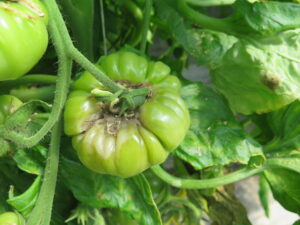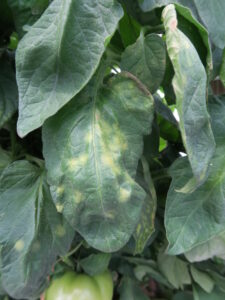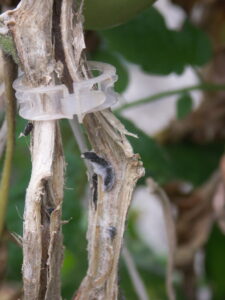The author of this article, Dan Egel, retired from Purdue University in February 2024.
This article is a brief review of the symptoms of foliar diseases of tomatoes in greenhouses or high tunnels. Remember that foliar diseases of tomatoes that are observed in greenhouses or high tunnels are different than those found in the field. This is because fungal diseases commonly found in the field require leaf moisture from rain or overhead irrigation. Below I list three common foliar diseases of tomato often found in greenhouses and discuss symptoms. For more information on this subject, see this link. Additional information and photos can be found here. For information about the tomato spotted wilt virus of tomatoes, see this link.
Gray Mold (Botrytis cinerea) Lesions are often a light brown or gray color (Figure 1). One can easily observe the growth of the causal fungus with a 10x hand lens. Gray mold may also cause lesions on stems and fruit. A fruit lesion is shown here (Figure 2).
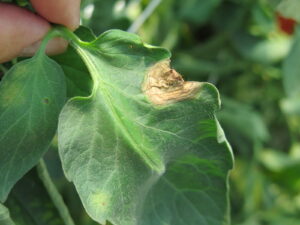
Figure 1. Gray mold causes light brown or gray necrotic lesions on tomato leaves. The growth of the fungus may be visible on the leaf.
Leaf Mold (Passalora fulva) Tomato leaves affected by leaf mold will often have light yellow lesions with diffuse edges (Figure 3). On the undersides of leaves, the fungus that causes leaf mold can clearly be seen as an olive-green “fuzz” (Figure 4). Under severe conditions, the fungus can be seen growing on the top of the leaf as well. Lesions do not appear on stems or fruit.
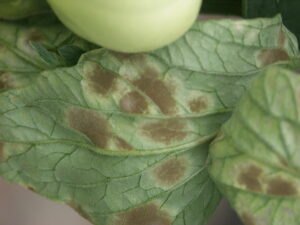
Figure 4. Leaf mold lesions on tomato can be recognized by the gray-green mold on the bottom of leaves.
White Mold (Sclerotinia sclerotiorum) The first symptom is often the wilting of scattered tomato plants. Upon closer inspection, the lower stem of an affected plant may have a light brown lesion that girdles the plant, causing it to wilt and possibly die. The lesions appear woody, which is how this disease got its alternate name: timber rot. The lesions are often accompanied by the white growth of the causal fungus as well as dark, irregularly shaped fungal structures (sclerotia) (see Figure 5). Sclerotia are found on the outside or inside of the stem and allow the fungus to overwinter for several years in the soil without a host. White mold may also cause rot of tomato fruit.
If you have questions about how to manage any one of these diseases, contact me. This article addresses possible confusion about the symptoms of these three diseases. It is always a good idea to submit plant samples that you are unsure about to the Plant and Pest Diagnostic laboratory.
